Objective: Desvenlafaxine is the third serotonin-norepinephrine reuptake inhibitor (SNRI) approved by the US Food and Drug Administration for major depressive disorder (MDD). This article summarizes data on the clinical pharmacology, efficacy, safety, and tolerability of desvenlafaxine (administered as desvenlafaxine succinate) for MDD with a focus on the 50-mg/d therapeutic dose. Additionally, the article discusses clinical practice considerations and future directions in desvenlafaxine research.
Data sources: Data relating to desvenlafaxine 50 mg/d were identified through searches of MEDLINE and publication databases of Pfizer for articles in English published before January 2009. Keywords were desvenlafaxine, O-desmethylvenlafaxine, ODV, and 50 mg.
Study selection: Three randomized, placebo- and/or active comparator-controlled, 8-week clinical trials reported the efficacy of desvenlafaxine 50 mg/d for the treatment of MDD. The third of these studies included a post hoc pooled analysis of data from all 3 of these trials. In addition, the search retrieved an article examining pooled data from 9 trials, including 50-mg data from 2 of the 3 retrieved trials.
Data synthesis: Desvenlafaxine is the major active metabolite of the SNRI venlafaxine. Significant improvements compared with placebo were observed on the primary efficacy measure (17-item Hamilton Depression Rating Scale total score) and most secondary measures in 2 of 3 clinical trials. An integrated analysis of registration data from 9 randomized, double-blind, placebo-controlled, 8-week studies of desvenlafaxine (50 to 400 mg/d) for MDD demonstrated no evidence of greater efficacy with doses higher than 50 mg/d. Safety results indicate that desvenlafaxine treatment is generally safe and well tolerated; findings were consistent with those for the SNRI class. The 50-mg/d dose of desvenlafaxine was associated with low rates of discontinuation due to treatment-emergent adverse events, which were similar to placebo.
Conclusions: Desvenlafaxine 50 mg/d has demonstrated efficacy, safety, and tolerability for the treatment of MDD in placebo-controlled trials. A long-term study is underway to further explore desvenlafaxine 50 mg/d for MDD.
Prim Care Companion J Clin Psychiatry 2010;12(3):e1-e10
Submitted: June 3, 2009; accepted October 21, 2009.
Published online: June 24, 2010 (doi:10.4088/PCC.09r00845blu).
Corresponding author: Michael R. Liebowitz, MD, 134 East 93rd St, Ste 201B, New York, NY 10128 ([email protected]).
Efficacy, Safety, and Tolerability of Desvenlafaxine 50 mg/d
for the Treatment of Major Depressive Disorder:
A Systematic Review of Clinical Trials
Objective: Desvenlafaxine is the third serotonin-norepinephrine reuptake inhibitor (SNRI) approved by the US Food and Drug Administration for major depressive disorder (MDD). This article summarizes data on the clinical pharmacology, efficacy, safety, and tolerability of desvenlafaxine (administered as desvenlafaxine succinate) for MDD with a focus on the 50-mg/d therapeutic dose. Additionally, the article discusses clinical practice considerations and future directions in desvenlafaxine research.
Data sources: Data relating to desvenlafaxine 50 mg/d were identified through searches of MEDLINE and publication databases of Pfizer for articles in English published before January 2009. Keywords were desvenlafaxine, O–desmethylvenlafaxine, ODV, and 50 mg.
Study selection: Three randomized, placebo- and/or active comparator–controlled, 8-week clinical trials reported the efficacy of desvenlafaxine 50 mg/d for the treatment of MDD. The third of these studies included a post hoc pooled analysis of data from all 3 of these trials. In addition, the search retrieved an article examining pooled data from 9 trials, including 50-mg data from 2 of the 3 retrieved trials.
Data synthesis: Desvenlafaxine is the major active metabolite of the SNRI venlafaxine. Significant improvements compared with placebo were observed on the primary efficacy measure (17-item Hamilton Depression Rating Scale total score) and most secondary measures in 2 of 3 clinical trials. An integrated analysis of registration data from 9 randomized, double-blind, placebo-controlled, 8-week studies of desvenlafaxine (50 to 400 mg/d) for MDD demonstrated no evidence of greater efficacy with doses higher than 50 mg/d. Safety results indicate that desvenlafaxine treatment is generally safe and well tolerated; findings were consistent with those for the SNRI class. The 50-mg/d dose of desvenlafaxine was associated with low rates of discontinuation due to treatment-emergent adverse events, which were similar to placebo.
Conclusions: Desvenlafaxine 50 mg/d has demonstrated efficacy, safety, and tolerability for the treatment of MDD in placebo-controlled trials. A long-term study is underway to further explore desvenlafaxine 50 mg/d for MDD.
Prim Care Companion J Clin Psychiatry 2010;12(3):e1–e10
© Copyright 2010 Physicians Postgraduate Press, Inc.
Submitted: June 3, 2009; accepted October 21, 2009.
Published online: June 24, 2010 (doi:10.4088/PCC.09r00845blu).
Corresponding author: Michael R. Liebowitz, MD, 134 East 93rd St, Ste 201B, New York, NY 10128 ([email protected]).
Major depressive disorder (MDD) is a common illness associated with serious impairment and substantial disability. An estimated 33 to 35 million Americans experience MDD during their lifetime, and 13 to 14 million are affected by MDD in a 12-month period.1 World Health Organization data from 60 countries worldwide indicate that depression impairs health to a greater degree than the chronic diseases angina, arthritis, asthma, and diabetes.2 Depression also is frequently comorbid with chronic diseases and physical conditions.2 World Health Organization projections of future mortality and disability rank MDD as a leading cause of disease burden worldwide by 2020, second only to ischemic heart disease.3
A range of effective antidepressants are available for the treatment of MDD4; however, an estimated 50% of patients do not receive adequate treatment for MDD,1 and many respond partially or not at all to treatment.5 For example, in the Sequenced Treatment Alternatives to Relieve Depression (STAR*D) study, approximately one-half of patients with MDD failed to respond to adequate first-line antidepressant monotherapy, and more than 65% failed to achieve remission.6 Thus, there remains a need for new agents that maximize efficacy and minimize side effects.4
The availability of selective serotonin reuptake inhibitors (SSRIs) and serotonin-norepinephrine reuptake inhibitors (SNRIs) has improved the treatment of MDD owing to safety and tolerability advantages over older tricyclic and heterocyclic agents.7 SSRIs primarily inhibit only serotonin reuptake, while dual-acting agents such as venlafaxine extended release (ER) and duloxetine, which also have demonstrated efficacy and safety for the treatment of MDD,8–11 are unique because they block the reuptake of both serotonin and norepinephrine.4 Serotonin and norepinephrine are implicated in the pathophysiology of MDD, since the functioning of the serotonin and norepinephrine systems appears to be dysregulated during depressive episodes.12 Complex interactions between serotonin and norepinephrine neurotransmitter systems, such as the inhibitory effect of serotonin on norepinephrine neurons, may mediate the wide range of psychological, physical, and functional symptoms of MDD.12,13
Desvenlafaxine (administered as desvenlafaxine succinate) is the third SNRI approved in the United States by the US Food and Drug Administration (FDA) for the treatment of MDD.14–16 Desvenlafaxine is formulated as an ER, film-coated tablet for once-daily, oral administration.14 A pooled analysis of all short-term, randomized, double-blind, placebo-controlled, fixed-dose registration trials has demonstrated the efficacy, safety, and tolerability of desvenlafaxine 50-, 100-, 200-, and 400-mg/d doses for the treatment of MDD.17–21 Across the dose range studied, treatment with desvenlafaxine was generally safe and well tolerated, with an adverse event (AE) profile consistent with other SNRI agents.17–20
Mechanism of Action
Desvenlafaxine, as desvenlafaxine succinate, is a novel salt form of the isolated major active metabolite (O-desmethylvenlafaxine) of the SNRI venlafaxine.22 Preclinical studies using competitive radioligand binding assays indicate that desvenlafaxine exhibits selective inhibitory activity of neurotransmitter uptake at the human serotonin and norepinephrine transporters.22 Higher affinity was found for the human serotonin transporter compared with the norepinephrine transporter, and weak affinity was observed for the human dopamine transporter.22 The assays indicate that desvenlafaxine is approximately 10-fold more potent at inhibiting serotonin uptake than norepinephrine uptake.22 All currently available SNRIs in the United States are more potent for serotonin than norepinephrine reuptake inhibition. The estimated sequential engagement ratio of serotonin inhibition relative to norepinephrine inhibition is approximately 9 for duloxetine,23 11 for desvenlafaxine,22 and 30 for venlafaxine ER.23 Of note, the ratios are based on in vitro studies performed with different assays; different methodologies may impact results. In addition, the relevance of in vitro findings to clinical outcomes is unknown; the in vivo effect is determined by various factors, such as pharmacokinetics and protein binding.22 Desvenlafaxine appears to have no monoamine oxidase inhibitory activity, and it shows virtually no affinity for muscarinic, cholinergic, H1-histaminergic, or α1-adrenergic receptors in vitro.14
Pharmacokinetics and Metabolism
Desvenlafaxine appears to be well absorbed after oral administration, and it has a large volume of distribution. Desvenlafaxine can be taken without regard to meals, and the absolute oral bioavailability after oral administration is approximately 80%.14 The mean terminal half-life (t1/2) is approximately 11 hours, and mean time to peak plasma concentrations (Tmax) after oral administration is approximately 7.5 hours.14 The pharmacokinetics of desvenlafaxine are minimally affected by food.14 Plasma protein binding of desvenlafaxine is low (30%) and independent of drug concentration.14
Studies of healthy volunteers indicate that desvenlafaxine undergoes extensive metabolism and is primarily renally excreted.14 Desvenlafaxine is metabolized primarily by conjugation in the liver (mediated by uridine-diphosphate glucuronosyltransferase isoforms) and, to a minor extent, through oxidative metabolism.14 The cytochrome P450 (CYP) isozyme 3A4 mediates the oxidative metabolism (N-demethylation).14 Desvenlafaxine metabolism is independent of the CYP2D6 metabolic pathway in the liver.14 The pharmacokinetics of desvenlafaxine have been shown to be similar in patients with CYP2D6 poor and extensive metabolizer phenotypes, and in vitro data have shown minimal inhibitory effects of desvenlafaxine on CYP2D6, suggesting low potential for drug-drug interactions with other CYP2D6 substrates.14,24 In vitro data also have shown that desvenlafaxine is not a substrate or an inhibitor of the P-glycoprotein (P-gp) transporter.25 Therefore, the pharmacokinetics of desvenlafaxine are unlikely to be affected by drugs that inhibit the P-gp transporter, and desvenlafaxine is not likely to alter the pharmacokinetics of drugs that are P-gp substrates.14
Elimination of desvenlafaxine is primarily as an unchanged compound or as a glucuronide metabolite. Approximately 45% of desvenlafaxine is excreted unchanged in urine at 72 hours after oral administration.14 Approximately 19% of the administered dose is excreted as the glucuronide metabolite, and less than 5% is excreted as the oxidative metabolite (N,O-didesmethylvenlafaxine).14
METHOD
The objectives of the current report are to summarize data on the clinical pharmacology, efficacy, safety, and tolerability of desvenlafaxine for the treatment of MDD with a focus on the 50-mg/d therapeutic dose. In addition, this article discusses clinical practice considerations as well as future directions in desvenlafaxine research.
Data relating to desvenlafaxine 50 mg/d were identified through searches of MEDLINE and publication databases of Pfizer for articles in English published before January 2009. Key words were desvenlafaxine, O–desmethylvenlafaxine, and ODV. Three randomized, placebo- and/or active comparator–controlled, 8-week clinical trials reported the efficacy of desvenlafaxine 50- mg/d for the treatment of MDD.
RESULTS
Efficacy
Table 1 summarizes clinical data relating to desvenlafaxine 50 mg/d for MDD. The individual studies17,19,26 included in this review were 8-week, randomized, placebo- and/or active comparator-controlled clinical trials that included desvenlafaxine 50 mg/d for the treatment of MDD. The 3 individual studies17,19,26 with the 50-mg/d dose also were analyzed via a post hoc pooled efficacy analysis included in the Tourian et al26 report. The post hoc analysis was designed to evaluate the efficacy of desvenlafaxine 50 and 100 mg/d in the context of all similarly designed, completed studies that included both the 50- and 100-mg/d doses for the treatment of MDD.26
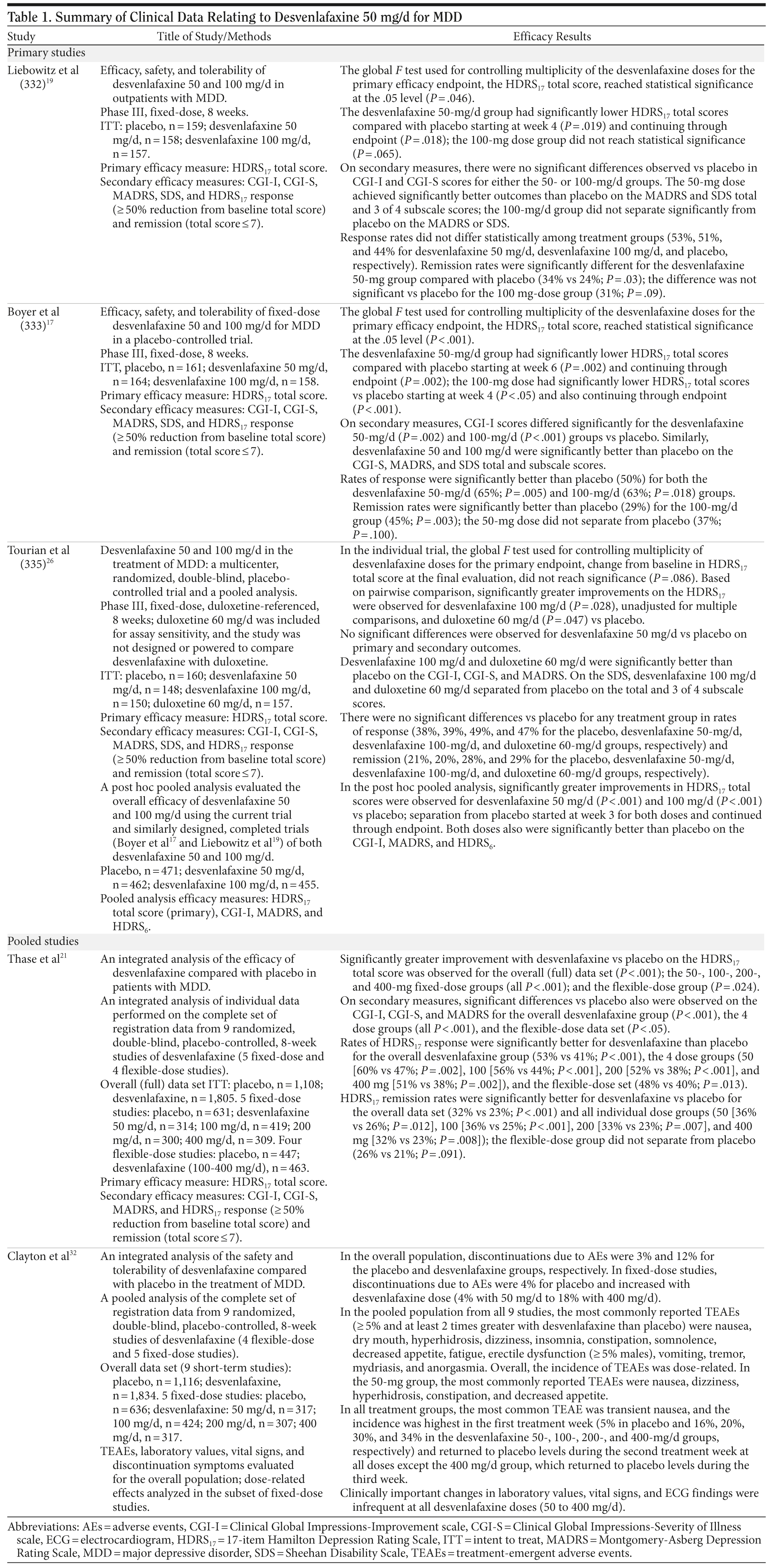
In addition to individual studies, pooled data from studies with the 50-mg/d dose and higher doses are presented in Table 1. Thase et al21 performed an integrated analysis of individual patient data from the complete set of registration data of desvenlafaxine for the treatment of MDD. Nine double-blind, placebo-controlled, 8-week phase II and III clinical trials of desvenlafaxine comprised the complete portfolio of FDA registration studies for MDD. Of the 9 studies in the analysis, 5 were fixed-dose in which patients were treated with desvenlafaxine 50 to 400 mg/d: 50 mg/d (2 studies), 100 mg/d (3 studies), 200 mg/d (3 studies), and 400 mg/d (3 studies).21 In the 4 flexible-dose studies, patients were treated with desvenlafaxine 100 to 400 mg/d: 100 to 200 mg/d (1 study) and 200 to 400 mg/d (3 studies).21 The Tourian et al26 study, completed later, was not included in the registration data set and was therefore not included in the integrated analysis.
In all studies in this review, participants were outpatient men and women ≥ 18 years of age with a primary diagnosis of MDD based on the criteria in the Diagnostic and Statistical Manual of Mental Disorders, Fourth Edition (DSM-IV)27 and in a single or recurrent episode, without psychotic features for at least 30 days before the screening visit. Minimum scores required at screening and baseline included a total score ≥ 20 on the 17-item Hamilton Depression Rating Scale (HDRS17)28 (≥ 20 or ≥ 22 in the Thase et al integrated analysis21), ≥ 2 on the HDRS17 item 1 (depressed mood), and ≥ 4 on the Clinical Global Impressions-Severity of Illness (CGI-S) scale.29 Major exclusion criteria included previous treatment with desvenlafaxine or known hypersensitivity to venlafaxine, significant risk of suicide based on clinical judgment, current Axis I disorder (other than MDD) or anxiety disorder, or any clinically important medical disease.17,19,26
Overall, baseline characteristics were largely similar in the 3 studies using 50 mg/d of desvenlafaxine.17,19,26 Mean HDRS17 total scores at baseline ranged from 23 to 24.17,19,26 In the Liebowitz et al19 trial, patient characteristics were similar among treatment groups, with the exception of baseline weight for desvenlafaxine 50 mg/d (P = .046) versus placebo; this difference was not expected to impact efficacy results. In the studies by Boyer et al17 and Tourian et al,26 there were no significant differences in either trial among treatment groups in pretreatment demographic and clinical characteristics.
The primary efficacy outcome for the 3 studies using 50 mg/d of desvenlafaxine17,19,26 as well as in all the studies in the Thase et al 9-study pooled efficacy analysis,21 was mean change from baseline to endpoint on the HDRS17 total score. Secondary outcomes included mean scores at endpoint on the Clinical Global Impressions-Improvement (CGI-I)29 scale and the CGI-S and mean changes from baseline to endpoint on the Montgomery-Asberg Depression Rating Scale30 (MADRS) and the patient-rated Sheehan Disability Scale31 ([SDS]; not analyzed in the 9-study pooled efficacy analysis21). Rates of HDRS17 response (≥ 50% reduction from baseline) and remission (total score ≤ 7) also were analyzed. In the 3-study, post hoc, pooled analysis presented in the Tourian et al26 report, efficacy measures were the HDRS17 total score (primary), CGI-I (adjusted means), MADRS, and HDRS6. The CGI-S, SDS, and rates of HDRS17 response and remission were not assessed in the post hoc analysis.
In all studies, the primary population for the efficacy analyses was the intent-to-treat (ITT) population, which included all patients who were randomly assigned to treatment, had a baseline primary efficacy evaluation, took at least 1 dose of study medication, and had at least 1 primary efficacy evaluation after the first dose of double-blind test medication. The primary endpoint for all efficacy analyses was the last-observation-carried-forward (LOCF) final evaluation; the LOCF method was used to account for missing data. Treatment effects were tested at a 2-sided significance level of .05. Multiplicity adjustment in the primary studies included closed testing procedures for the primary efficacy variable (the HDRS17 change from baseline at the LOCF final evaluation) that was performed to compare 2 doses of desvenlafaxine (50 and 100 mg/d) with placebo. A sequential testing method was used to control for multiplicity in the primary (HDRS17 total score) and 1 secondary efficacy variable (CGI-I). No adjustment for multiplicity was made for other secondary efficacy variables.17,19,26
Table 1 presents study designs and efficacy results for the individual studies and pooled analyses which included desvenlafaxine 50 mg/d. On the primary efficacy measure, the desvenlafaxine 50-mg/d dose group had significantly lower HDRS17 total scores at endpoint compared with placebo in 2 studies,17,19 the 3-study post hoc pooled analysis,26 and the 9-study pooled efficacy analysis.21 Adjusted mean HDRS17 total scores over time (LOCF, ITT) for all studies are shown in Figures 1, 2, 3A, and 3B. In the Tourian et al26 trial, HDRS17 total scores were not significantly different for desvenlafaxine 50 mg/d versus placebo. The global F test used for controlling multiplicity of the desvenlafaxine doses for the primary efficacy endpoint, the change from baseline in the HDRS17 total score at the final evaluation, did not reach significance at the .05 level (P = .086); based on pairwise comparison (unadjusted for multiple comparisons), no significant differences were observed for desvenlafaxine 50 mg/d versus placebo on primary and secondary outcomes. The global F test used for controlling multiplicity of the desvenlafaxine doses for the primary efficacy endpoint, the HDRS17 total score, reached statistical significance at the .05 level in both the Liebowitz et al trial19 (P = .046) and the Boyer et al trial17 (P < .001). Results of the Thase et al21 integrated analysis of individual patient data from the all-inclusive set of 9 short-term, placebo-controlled trials demonstrated efficacy across the range of desvenlafaxine doses studied; all 4 doses (50, 100, 200, and 400 mg/d) had significantly greater improvement on the HDRS17, with no evidence of greater efficacy at doses higher than 50 mg/d.
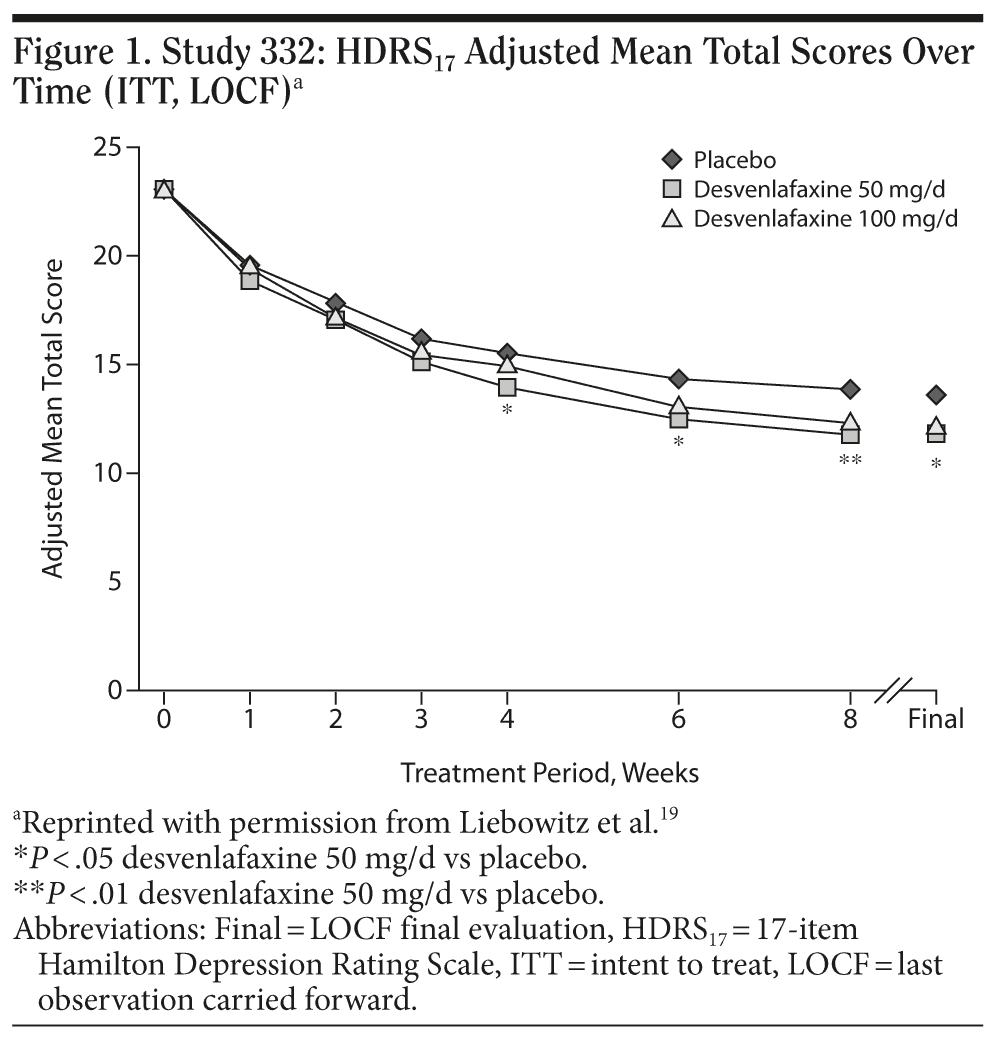
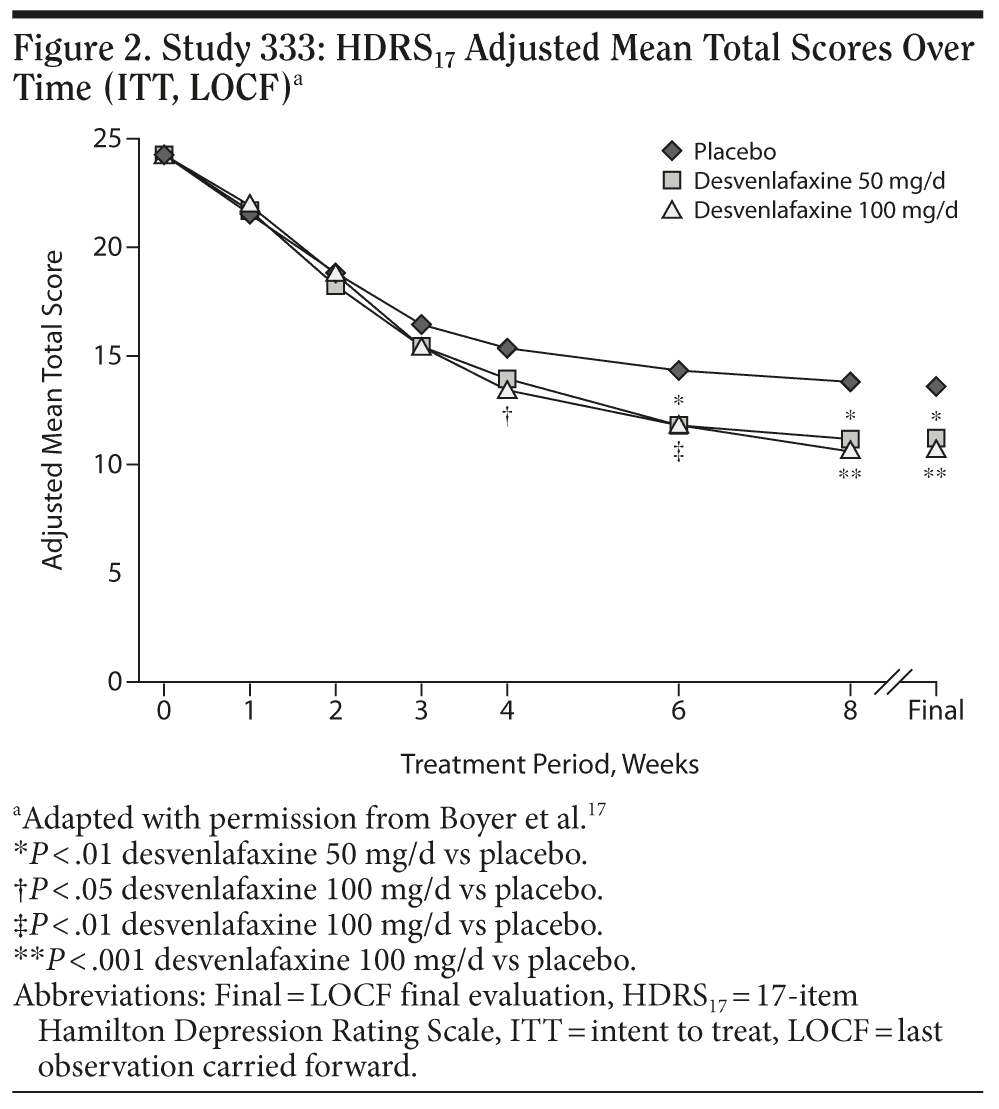
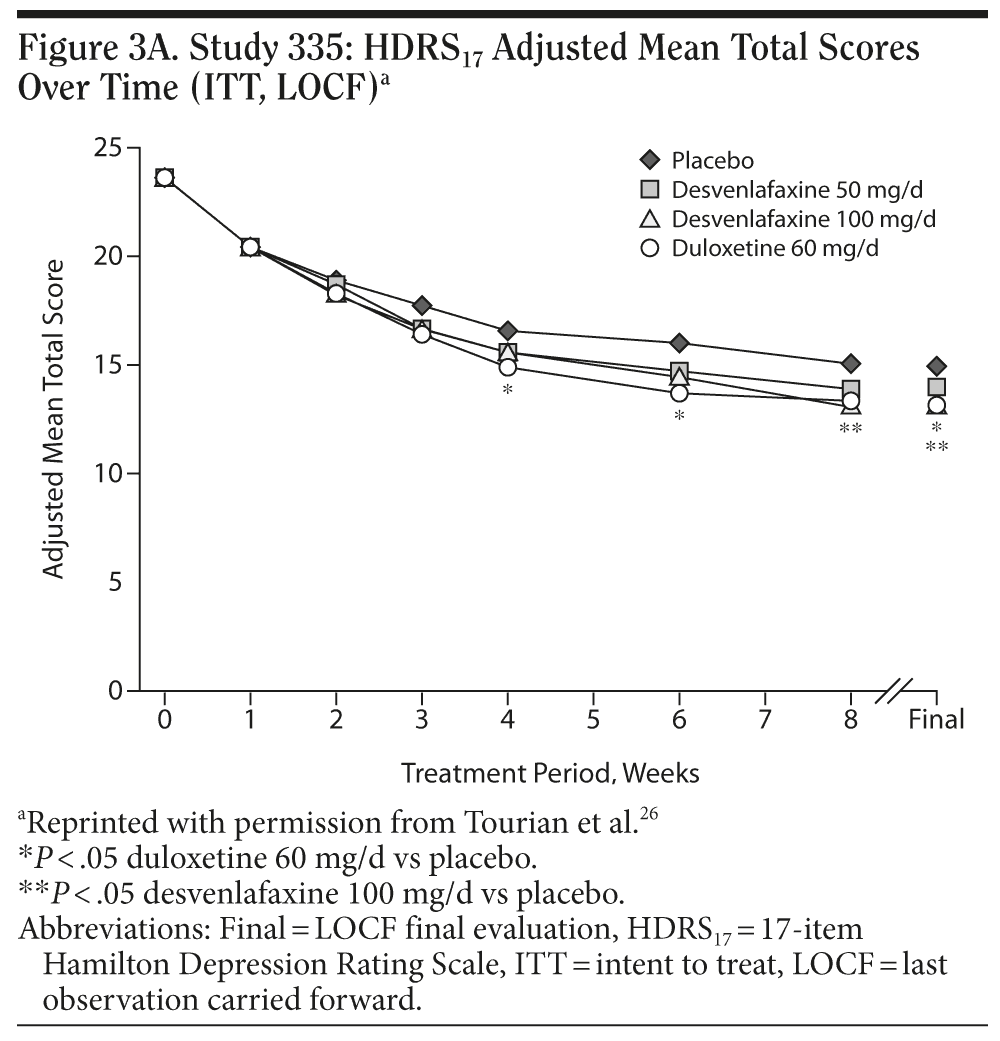
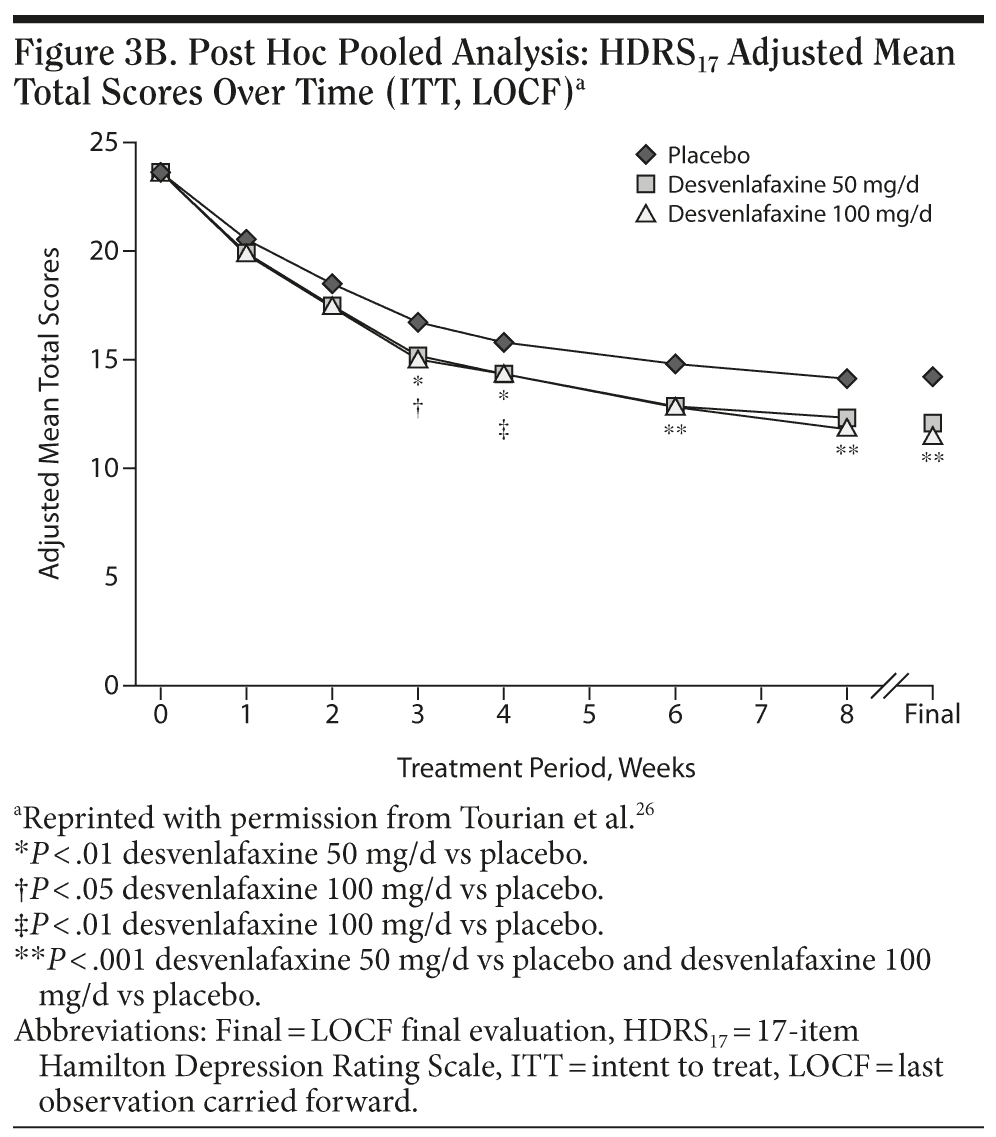
Most secondary measures showed significant separation from placebo. CGI-I scores (adjusted means) differed significantly for desvenlafaxine 50 mg/d versus placebo in 1 trial (Boyer et al17), the 3-study post hoc pooled analysis,26 and the 9-study pooled efficacy analysis21; nonsignificant results were observed in 2 trials (Liebowitz et al19 and Tourian et al26). CGI-S scores were significantly better for desvenlafaxine 50 mg/d versus placebo in 1 trial (Boyer et al17) and the 9-study, pooled efficacy analysis21; nonsignificant results were observed in 2 trials (Liebowitz et al19 and Tourian et al26). CGI-S scores were not assessed in the 3-study, post hoc, pooled analysis.26 MADRS scores differed significantly for desvenlafaxine 50 mg/d versus placebo in 2 trials (Boyer et al17 and Liebowitz et al19); the 3-study, post hoc, pooled analysis26; and the 9-study, pooled efficacy analysis21; nonsignificant results were observed in 1 trial.26 SDS total and subscale scores showed significant improvements for desvenlafaxine 50 mg/d versus placebo in 2 trials (Boyer et al17 and Liebowitz et al19) but not in the Tourian et al26 trial. SDS total and subscale scores were not assessed in the 3-study, post hoc, pooled analysis26 or in the 9-study, efficacy pooled analysis.21
Rates of HDRS17 response (≥ 50% reduction from baseline total score) were significantly greater for desvenlafaxine 50 mg/d versus placebo in 1 trial (Boyer et al17) and the 9-study, pooled efficacy analysis.21 Specifically, response rates for placebo and desvenlafaxine 50 mg/d were 44% and 53% (P = .098), respectively, in the Liebowitz et al trial19; 50% and 65% (P = .005), respectively, in the Boyer et al17 trial; 38% and 39% (P = .961), respectively, in the Tourian et al26 trial; and 47% and 60% (P = .002), respectively, in the 9-study, pooled efficacy analysis.21 HDRS17 response was not assessed in the 3-study, post hoc, pooled analysis.26
Rates of HDRS17 remission (total score ≤ 7) were significantly greater for desvenlafaxine 50 mg/d versus placebo in 1 trial (Liebowitz et al19) and the 9-study pooled efficacy analysis.21 Remission rates for placebo and desvenlafaxine 50 mg/d were 24% and 34% (P = .03), respectively, in the Liebowitz et al trial19; 29% and 37% (P = .10 vs placebo), respectively, in the Boyer et al17 trial; 21% and 20% (P = .82), respectively, in the Tourian et al trial26; and 26% and 36% (P = .012), respectively, in the 9-study, pooled efficacy analysis (odds ratio [95% CI]: 1.55 [1.10–2.18]).21 HDRS17 remission was not assessed in the 3-study, post hoc, pooled analysis.26
Overall, the results demonstrate the efficacy of desvenlafaxine 50 mg/d for the treatment of MDD. Significant improvements compared with placebo were observed on the primary efficacy measure (HDRS17) in all but 1 trial26 as well as on most secondary measures in all but 1 trial.26 Efficacy was demonstrated on both clinician- and patient-rated measures of depression. Remission rates in the individual studies and the 9-study post hoc analysis (range, 20%–37%) were generally consistent with the rate of HDRS remission (27.5%) reported for patients treated with open-label citalopram in the STAR*D study6; however, the remission rate in the STAR*D study may be somewhat inflated compared with those in the desvenlafaxine studies, as a placebo control group was not included in STAR*D.6 The post hoc pooled efficacy analysis of the 3 completed, similarly designed clinical trials, including the Tourian et al trial,26 with both desvenlafaxine 50- and 100- mg/d doses, supported the overall similar efficacy of both desvenlafaxine doses for MDD.26 Based on the pooled integrated analysis of 9 registration studies, desvenlafaxine demonstrated efficacy on both standard rating scales and categorical outcomes across the entire range of doses studied; no evidence of greater efficacy was observed with doses higher than 50 mg/d.21
Safety
In the individual studies, safety assessments included monitoring of spontaneously reported treatment-emergent adverse events (TEAEs) and assessment of vital signs, laboratory tests, physical examinations, and electrocardiograms (ECGs). Safety was evaluated in the safety population, defined as all randomly assigned patients who took at least 1 dose of double-blind test medication. The most common TEAEs observed in each of the 3 placebo-controlled trials are presented in Table 2.
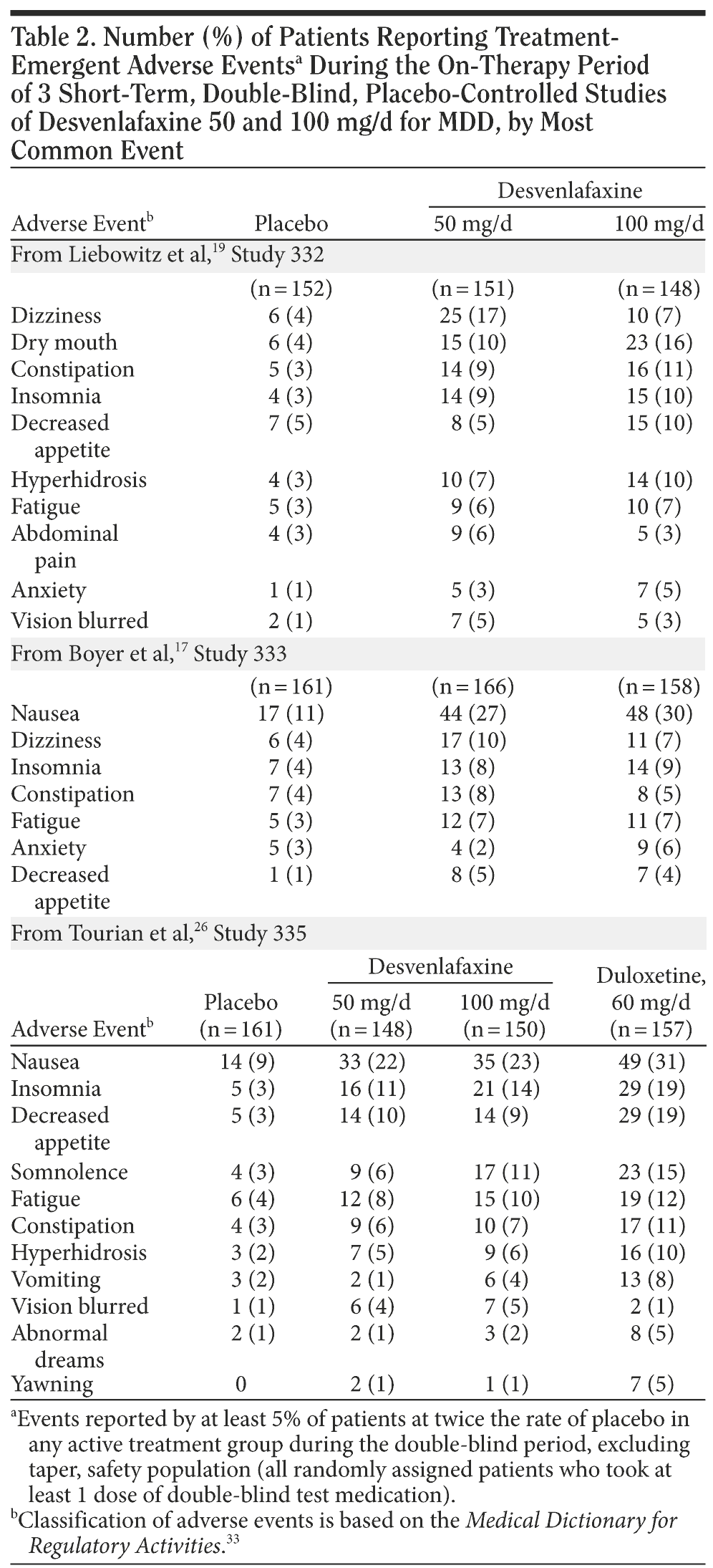
The pooled safety analysis with the 50-mg/d dose by Clayton et al32 is included in Table 1. Clayton et al conducted a pooled safety analysis of the 9 short-term, randomized, double-blind, placebo-controlled registration studies for MDD. Treatment-emergent adverse events, laboratory values, vital signs, and discontinuation symptoms were assessed in the safety population. Data were analyzed from all 9 registration studies combined (4 flexible-dose and 5 fixed-dose studies) to assess the overall safety and tolerability of desvenlafaxine. Additionally, data were analyzed from the 5 fixed-dose studies to evaluate safety and tolerability outcomes in relation to dose.32
In the pooled safety analysis, desvenlafaxine exhibited a safety and tolerability profile generally consistent with that of the SNRI class. Overall, discontinuations due to AEs were dose related and occurred most often in the first week of treatment. In the subgroup of fixed-dose studies, discontinuation rates in the placebo and 50-mg/d desvenlafaxine groups were both 4%, with no single AE accounting for ≥ 1% of patients’ stopping study medication.32
Table 3 summarizes the most common TEAEs observed in the pooled safety analysis. Overall, the incidence of TEAEs was dose related. The most common TEAE observed across all doses was transient nausea, which was generally mild to moderate in severity. In the 50-mg/d group, the incidence of nausea was highest in the first treatment week (5% and 16% in the placebo and desvenlafaxine 50-mg/d groups, respectively), and it decreased to placebo levels during the second treatment week.32

In the pooled safety analysis,32 the most common taper/poststudy-emergent AEs (TPAEs) occurring in ≥ 5% of patients and ≥ 2 times more frequently with desvenlafaxine than with placebo) in the total set of 9 registration studies were nausea (2% and 7% for placebo and desvenlafaxine, respectively) and dizziness (2% and 9% for placebo and desvenlafaxine, respectively). In the 5 fixed-dose studies, the incidence of TPAEs was 27% with placebo and 47% (50 mg), 43% (100 mg), 32% (200 mg), and 38% (400 mg) with desvenlafaxine. A dose-response relationship was not observed for any of the most-common TPAEs.32
Across all studies, few clinically significant changes were observed in laboratory, vital sign, weight, and ECG assessments. Overall, the results demonstrated that desvenlafaxine treatment was generally safe and well tolerated.17,19,26,32 Across the dose range, findings were consistent with those of the SNRI class.32
Clinical Practice Considerations
The recommended therapeutic dose for desvenlafaxine is 50 mg once daily, with or without food, and the 50-mg/d dose can be initiated without titration.14 Most side effects with desvenlafaxine, including the 50 mg/d dose, occur in the first week of treatment and resolve shortly thereafter.14 Specifically, discontinuations due to AEs occur most often in the first week of treatment, and the incidence of nausea, which is the most common side effect observed across all desvenlafaxine doses, is highest during the first week of treatment.32 In clinical trials, nausea was generally mild to moderate in severity, and it resolved without treatment.32
Counseling patients about side effects is important, since research shows that, among adults who initiate antidepressant treatment, 42% discontinue during the first 30 days of treatment, and 72% discontinue during the first 90 days.34 In addition, patients who discuss side effects with their physicians are less likely to discontinue treatment than patients who do not discuss side effects and also are more likely to switch medications.35 Women in particular may be more sensitive to gastrointestinal-related side effects than men, and they should be advised accordingly.36,37
Considerations for special populations include patients with renal or hepatic impairment.14 Dosage adjustment is not necessary in patients with mild renal impairment, defined as a 24-hour creatinine clearance (CrCl) of 50 to 80 mL/min. The recommended desvenlafaxine dose is 50 mg/d in patients with moderate renal impairment, defined as a 24-hour CrCl of 30 to 50 mL/min. In patients with severe renal impairment (24-hr CrCl of 30 mL/min) or end-stage renal disease, the recommended dose is 50 mg every other day; doses should not be escalated in patients with moderate or severe renal impairment or end-stage renal disease. In addition, supplemental doses should not be given to patients after dialysis. For patients with hepatic impairment, no adjustment of the starting dosage is necessary; however, dose escalation greater than 100 mg/d is not recommended.14
Higher doses of desvenlafaxine (ie, 100, 200, and 400 mg/d) have been examined in several studies of healthy patients with MDD. The efficacy, safety, and tolerability of desvenlafaxine for MDD have been demonstrated in 4 double-blind, randomized, fixed-dose, placebo-controlled trials of desvenlafaxine doses ranging from 50 to 400 mg/d.17–20 Additionally, as mentioned earlier, Thase et al21 performed an integrated analysis on the complete set of registration data from 9 randomized, double-blind, placebo-controlled, 8-week studies of desvenlafaxine. Patients received fixed- (50, 100, 200, or 400 mg/d; n = 1,342) or flexible-dose (100 to 400 mg/d, n = 463) desvenlafaxine or placebo (n = 1,108). Significantly greater improvement was observed for desvenlafaxine versus placebo on the primary (HDRS17) and secondary (CGI-I, CGI-S, and MADRS) outcomes for the overall desvenlafaxine group, the 4 dose groups, and the flexible-dose data set.21 In general, desvenlafaxine doses up to 400 mg/d have been shown to be effective for MDD, although no additional benefit has been demonstrated at doses greater than 50 mg/d, and AEs and discontinuations are more frequent at higher doses.14
Future Directions
Future studies of desvenlafaxine for MDD are planned. At this time, the lowest effective dose of desvenlafaxine has not yet been identified. Two phase III, multicenter, randomized, double-blind, placebo-controlled, parallel-group trials were scheduled to be initiated in 2009 to evaluate the efficacy, safety, and tolerability of desvenlafaxine at doses lower than 50 mg/d for the treatment of MDD in adult outpatients. In addition, a long-term clinical trial of desvenlafaxine 50 mg/d in adult outpatients with MDD will be initiated to evaluate the efficacy of desvenlafaxine for reducing relapse rates of MDD. The study will be conducted in the United States, Europe, and Latin America. Patients will first receive 8-week, open-label desvenlafaxine treatment, after which responders will be eligible to enter a 12-week, open-label treatment phase for stabilization (to maintain response); patients who respond to open-label treatment will then be randomly assigned to double-blind desvenlafaxine 50 mg/d or placebo in a 6-month, relapse-assessment phase.
CONCLUSION
Desvenlafaxine is the third SNRI approved in the United States for the treatment of MDD.14 Overall, desvenlafaxine 50 mg/d demonstrated efficacy for the treatment of MDD in placebo-controlled trials. No additional benefit was demonstrated at doses higher than 50 mg/d. However, studies of higher doses in patients not responding to adequate trials of 50 mg/d have not been done. The overall safety results from placebo-controlled trials indicate that treatment with desvenlafaxine is generally safe and well tolerated, and the findings are consistent with the SNRI class. Desvenlafaxine can be initiated with the 50-mg/d therapeutic dose without titration, and it provides efficacy with low rates of discontinuation due to TEAEs, particularly for the 50-mg/d dose. Desvenlafaxine has minimal interaction with the CYP450 system, which may minimize potential drug-drug interactions. Additional lower-dose and long-term studies are underway to further explore the efficacy, safety, and tolerability of desvenlafaxine for MDD.
Drug names: citalopram (Celexa, Lexapro, and others), desvenlafaxine (Pristiq), duloxetine (Cymbalta), venlafaxine (Effexor and others).
Author affiliations: Columbia University and the Medical Research Network, New York, New York (Dr Liebowitz); and Wyeth, a Company of the Pfizer Group, Division Wyeth Research, Paris, France (Dr Tourian).
Potential conflicts of interest: Dr Liebowitz reports equity ownership in ChiMatrix LLC and the Liebowitz Social Anxiety Scale (LSAS); is a consultant to AstraZeneca, Tikvah, Wyeth, Eli Lilly, Pherin, and Jazz; has licensed LSAS software to GlaxoSmithKline, Pfizer, Avera, Tikvah, Eli Lilly, Indevus, and Servier; is on the speakers bureaus for Wyeth, AstraZeneca, Bristol-Myers Squibb, and Jazz; and has received grant/research support from Pfizer, GlaxoSmithKline, AstraZeneca, Forest, Tikvah, Avera, Eli Lilly, Novartis, Sepracor, Horizon, Johnson & Johnson, Pherin, PGX Health, Abbott, Jazz, MAP, Takeda, Wyeth, Cephalon, Allergan, Indevus, Endo, Ortho-McNeil, and Grunthal. Dr Tourian is an employee and stock shareholder of Wyeth, a Company of the Pfizer Group, Division Wyeth Research, Paris, France.
Funding/support: This analysis was sponsored by Wyeth Research, Collegeville, Pennsylvania, which was acquired by Pfizer Inc in October 2009. Medical writing support was funded by Wyeth and was provided by Sherri Jones, PharmD, of Embryon, LLC, a Division of Advanced Health Media, LLC (formerly Medesta Publications Group, a Business of Advogent).
Previous presentation: Information presented in this manuscript has been presented as a poster at the International Society for Affective Disorders Regional Meeting, February 28–March 2, 2009, Brisbane, Australia; the College of Psychiatric and Neurologic Pharmacists 12th Annual Meeting, April 19–22, 2009, Jacksonville, Florida; and the 9th World Congress of Biological Psychiatry, June 28–July 2, 2009, Paris, France.
REFERENCES
1. Kessler RC, Berglund P, Demler O, et al, National Comorbidity Survey Replication. The epidemiology of major depressive disorder: results from the National Comorbidity Survey Replication (NCS-R). JAMA. 2003;289(23):3095–3105. doi:10.1001/jama.289.23.3095 PubMed
2. Moussavi S, Chatterji S, Verdes E, et al. Depression, chronic diseases, and decrements in health: results from the World Health Surveys. Lancet. 2007;370(9590):851–858. doi:10.1016/S0140-6736(07)61415-9 PubMed
3. Murray CJ, Lopez AD. Alternative projections of mortality and disability by cause 1990–2020: global burden of disease study. Lancet. 1997;349(9064):1498–1504. doi:10.1016/S0140-6736(96)07492-2 PubMed
4. Schatzberg AF. Safety and tolerability of antidepressants: weighing the impact on treatment decisions. J Clin Psychiatry. 2007;68(suppl 8):26–34. PubMed
5. Fava M, Davidson KG. Definition and epidemiology of treatment-resistant depression. Psychiatr Clin North Am. 1996;19(2):179–200. doi:10.1016/S0193-953X(05)70283-5 PubMed
6. Trivedi MH, Rush AJ, Wisniewski SR, et al. STAR*D Study Team. Evaluation of outcomes with citalopram for depression using measurement-based care in STAR*D: implications for clinical practice. Am J Psychiatry. 2006;163(1):28–40. doi:10.1176/appi.ajp.163.1.28 PubMed
7. Andrews JM, Nemeroff CB. Contemporary management of depression. Am J Med. 1994;97(6A):24S–32S. doi:10.1016/0002-9343(94)90360-3 PubMed
8. Smith D, Dempster C, Glanville J, et al. Efficacy and tolerability of venlafaxine compared with selective serotonin reuptake inhibitors and other antidepressants: a meta-analysis. Br J Psychiatry. 2002;180(5):396–404. doi:10.1192/bjp.180.5.396 PubMed
9. Thase ME, Entsuah AR, Rudolph RL. Remission rates during treatment with venlafaxine or selective serotonin reuptake inhibitors. Br J Psychiatry. 2001;178(3):234–241. doi:10.1192/bjp.178.3.234 PubMed
10. Shelton RC, Andorn AC, Mallinckrodt CH, et al. Evidence for the efficacy of duloxetine in treating mild, moderate, and severe depression. Int Clin Psychopharmacol. 2007;22(6):348–355. doi:10.1097/YIC.0b013e32821c6189 PubMed
11. Detke MJ, Lu Y, Goldstein DJ, et al. Duloxetine 60 mg once daily dosing versus placebo in the acute treatment of major depression. J Psychiatr Res. 2002;36(6):383–390. doi:10.1016/S0022-3956(02)00060-2 PubMed
12. Stahl SM. The psychopharmacology of painful physical symptoms in depression. J Clin Psychiatry. 2002;63(5):382–383. PubMed
13. Blier P. Crosstalk between the norepinephrine and serotonin systems and its role in the antidepressant response. J Psychiatry Neurosci. 2001;26(suppl):S3–S10. PubMed
14. Pristiq [package insert]. Philadelphia, PA: Wyeth Pharmaceuticals Inc; 2008.
15. Cymbalta [package insert]. Indianapolis, IN: Eli Lilly and Company; 2007.
16. Effexor XR [package insert]. Philadelphia, PA: Wyeth Pharmaceuticals Inc; 2006.
17. Boyer P, Montgomery S, Lepola U, et al. Efficacy, safety, and tolerability of fixed-dose desvenlafaxine 50 and 100 mg/day for major depressive disorder in a placebo-controlled trial. Int Clin Psychopharmacol. 2008;23(5):243–253. doi:10.1097/YIC.0b013e32830cebed PubMed
18. DeMartinis NA, Yeung PP, Entsuah R, et al. A double-blind, placebo-controlled study of the efficacy and safety of desvenlafaxine succinate in the treatment of major depressive disorder. J Clin Psychiatry. 2007;68(5):677–688. doi:10.4088/JCP.v68n0504 PubMed
19. Liebowitz MR, Manley AL, Padmanabhan SK, et al. Efficacy, safety, and tolerability of desvenlafaxine 50 mg/day and 100 mg/day in outpatients with major depressive disorder. Curr Med Res Opin. 2008;24(7):1877–1890. doi:10.1185/03007990802161923 PubMed
20. Septien-Velez L, Pitrosky B, Padmanabhan SK, et al. A randomized, double-blind, placebo-controlled trial of desvenlafaxine succinate in the treatment of major depressive disorder. Int Clin Psychopharmacol. 2007;22(6):338–347. doi:10.1097/YIC.0b013e3281e2c84b PubMed
21. Thase ME, Kornstein SG, Germain JM, et al. An integrated analysis of the efficacy of desvenlafaxine compared with placebo in patients with major depressive disorder. CNS Spectr. 2009;14(3):144–154. PubMed
22. Deecher DC, Beyer CE, Johnston G, et al. Desvenlafaxine succinate: a new serotonin and norepinephrine reuptake inhibitor. J Pharmacol Exp Ther. 2006;318(2):657–665. doi:10.1124/jpet.106.103382 PubMed
23. Dugan SE, Fuller MA. Duloxetine: a dual reuptake inhibitor. Ann Pharmacother. 2004;38(12):2078–2085. doi:10.1345/aph.1E084 PubMed
24. Patroneva A, Connolly SM, Fatato P, et al. An assessment of drug-drug interactions: the effect of desvenlafaxine and duloxetine on the pharmacokinetics of the CYP2D6 probe desipramine in healthy subjects. Drug Metab Dispos. 2008;36(12):2484–2491. doi:10.1124/dmd.108.021527 PubMed
25. Oganesian A, Shilling A, Young-Sciame R, et al. Desvenlafaxine succinate, venlafaxine, duloxetine, paroxetine, sertraline, and bupropion: comparing inhibitory effects on human cytochrome P450 and P-glycoprotein activities. Poster presented at the 14th North American International Society for the Study of Xenobiotics Meeting; October 22–26, 2006; Rio Grande, Puerto Rico.
26. Tourian KA, Padmanabhan SK, Groark J, et al. Desvenlafaxine 50 and 100 mg/d in the treatment of major depressive disorder: an 8-week, phase III, multicenter, randomized, double-blind, placebo-controlled, parallel-group trial and a post hoc pooled analysis of three studies. Clin Ther. 2009;31(pt 1):1405–1423. doi:10.1016/j.clinthera.2009.07.006 PubMed
27. American Psychiatric Association. Diagnostic and Statistical Manual of Mental Disorders, Fourth Edition. Washington, DC: American Psychiatric Association; 1994.
28. Hamilton M. A rating scale for depression. J Neurol Neurosurg Psychiatry. 1960;23(1):56–62. doi:10.1136/jnnp.23.1.56 PubMed
29. Guy W, ed. ECDEU Assessment Manual for Psychopharmacology. US Dept Health, Education, and Welfare publication (ADM) 76-338. Rockville, MD: National Institute of Mental Health;1976:218–222.
30. Montgomery SA, Asberg M. A new depression scale designed to be sensitive to change. Br J Psychiatry. 1979;134(4):382–389. doi:10.1192/bjp.134.4.382 PubMed
31. Sheehan DV, Lecrubier Y, Sheehan KH, et al. The Mini-International Neuropsychiatric Interview (MINI): the development and validation of a structured diagnostic psychiatric interview for DSM-IV and ICD-10. J Clin Psychiatry. 1998;59(suppl 20):22–33, quiz 34–57. PubMed
32. Clayton AH, Kornstein SG, Rosas G, et al. An integrated analysis of the safety and tolerability of desvenlafaxine compared with placebo in the treatment of major depressive disorder. CNS Spectr. 2009;14(4):183–195. PubMed
33. International Conference on Harmonization of Technical Requirements for Registration of Pharmaceuticals for Human Use. Medical Dictionary for Regulatory Activities. http://www.meddramsso.com/index.asp. Accessed May 4, 2010.
34. Olfson M, Marcus SC, Tedeschi M, et al. Continuity of antidepressant treatment for adults with depression in the United States. Am J Psychiatry. 2006;163(1):101–108. doi:10.1176/appi.ajp.163.1.101 PubMed
35. Bull SA, Hu XH, Hunkeler EM, et al. Discontinuation of use and switching of antidepressants: influence of patient-physician communication. JAMA. 2002;288(11):1403–1409. doi:10.1001/jama.288.11.1403 PubMed
36. Sagud M, Hotujac Lj, Mihaljević-Peles A, et al. Gender differences in depression. Coll Antropol. 2002;26(1):149–157. PubMed
37. Stewart DE, Wohlreich MM, Mallinckrodt CH, et al. Duloxetine in the treatment of major depressive disorder: comparisons of safety and tolerability in male and female patients. J Affect Disord. 2006;94(1–3):183–189. doi:10.1016/j.jad.2006.04.006 PubMed
Please sign in or purchase this PDF for $40.00.
Save
Cite
